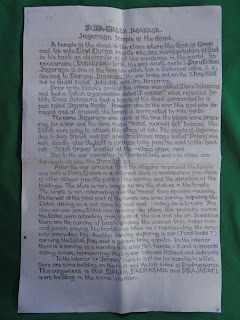(apologies for image quality)
Tonight we're in for a treat, we've an invitation to a semi-annual Hindu religious ceremony at the temple of the extended family of Pak Gede. We've discussed how to get there and as we understand it, we go up to the main road, take a right then a left and we're there. It turns out that we're going by motorcycle, Pat and I on the back of separate scooters, in the dark, both with sarongs, observing protocol. Hold onto my Balinese hat. It was a left, not a right, and then a right, up about a mile, another right at the round-about, then take your first left (I think), up about a quarter mile. You can't miss it, there's a crowd gathering. Good thing Pak and his friend gave us a ride.
We arrive from the dark into a fairly well lit alleyway lined with fifty or so scooters parked and people milling about. “Go straight back down the alley”, and we do, through a small temple gate to a large concrete patio slab with a sort of pagoda in the center (please excuse the mixed religious context here) with lots of fruit piled up. We are accidentally greeted by a young man who speaks fluent English, and tells us we can sit anywhere.
There are no chairs so off to one corner we park ourselves, backs to the wall. Very, very lucky for us, our English speaking narrator, Sudiano, gives Pat a blow-by-blow. (She should be writing this.) Soon another forty or fifty people arrive, filling up the place. We're all sitting on the ground, except those in the central pagoda, and those in the
Gamelan on the far side under a small lanai.
 |
| Sudiano |
 |
| pleanty of seating |
 |
| blow-by-blow |
It seems it's a nice time to chat; everyone is chatting with their neighbors, a social gathering as much as anything else, while some few are directly involved in the ritual offerings, incense burning, and sprinkling with holy water. The food is for the god(s), apparently not for the people, though had we stayed later, maybe. There is a cacophony of music when, from neighboring temple, like right next door, their gamelan starts up just after ours.
 |
| everybody's here |
These guys, in the gamelan, play all the while the offerings are made, and the rest of us are chatting away, until it's time for the prayers, followed by the message, when all goes quiet and someone gives something of a short sermon – we're all equal and should respect one another.
prayer
holy water
Then we all get up. As for the locals, they mill about, and we head back the way we came, on foot, in the dark, forgetting exactly how the hell we got here, and after asking a few folks, doing a 180, and walking down a dark road for about a mile (lucky for us I brought a flashlight), we made it.
This evening is really very special for us, and we have Pak Gede to thank, and many thanks to the larger family for allowing us to witness. Pak Gede owns a
homestay in desa Anturan, and can serve all your needs.
So, how did it feel, there in the midst? I provide the clips and photos so you can get a bit of the flavor. It was fascinating, an unforgettable experience. It's one thing to walk through a Balinese temple, and yet quite another to be part of the ceremony.






